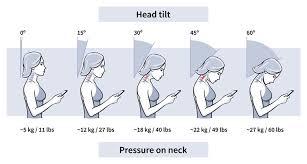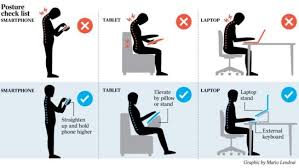
How Your Phone Is Wrecking Your Posture—and What to Do About It
Scrolling through social media. Replying to emails. Bingeing TikToks.
It’s no secret—we’re glued to our phones. But what most people don’t realize is just how much that tiny screen is silently sabotaging your spine.
Experts are calling it tech neck—and if you’ve felt stiff shoulders, tightness in your back, or a nagging neck ache, your smartphone might be the real culprit.
Let’s break down the problem and, more importantly, what you can do to fix it.
📱 The “Text Neck” Epidemic
On average, people spend 3 to 5 hours a day looking down at their phones. That’s over 1,400 hours a year placing strain on the muscles and joints of your neck.
When your head is upright, it weighs about 10 to 12 pounds. But tilt it forward even 30 degrees, and the force on your neck increases to nearly 40 pounds. At 60 degrees? You’re looking at 60 pounds of pressure on your spine.
Now imagine holding a 7-year-old child on the back of your neck—for hours, every single day.
No wonder so many of us are hurting.
⚠️ The Warning Signs You’re Ignoring
Think you’re fine? These are subtle red flags of phone-induced posture problems:
-
Tightness or pain in the neck or shoulders
-
Frequent headaches
-
Tingling or numbness in the arms or hands
-
A “hunched” look in the mirror
-
Reduced range of motion when turning your head
-
Feeling stiff when standing up after sitting
Left unchecked, poor posture doesn’t just cause discomfort—it can lead to long-term spinal misalignment, chronic pain, and even nerve damage.
🧠 The Posture-Mood Connection
Slouching affects more than just your muscles—it can impact your mood and confidence. Research shows that poor posture can lead to increased stress, lower self-esteem, and even reduced memory performance.
Standing tall, on the other hand, is linked with increased energy, sharper focus, and improved breathing.
Good posture isn’t just about appearance—it’s about how you feel and function.
💡 5 Simple Fixes to Save Your Spine
Ready to undo the damage? These small, consistent changes can make a big difference:
1. Raise Your Screen
Hold your phone at eye level to reduce the forward tilt of your head. When using a laptop or desktop, elevate it with a stand or stack of books.
2. Take Tech Breaks
Follow the 20-20-20 rule: Every 20 minutes, look 20 feet away for at least 20 seconds. Bonus: Stand up and stretch!
3. Strengthen and Stretch
Add posture-focused exercises to your routine:
-
Chin tucks
-
Shoulder blade squeezes
-
Neck rolls
-
Chest-opening stretches
Yoga and Pilates are also great for realigning posture and improving flexibility.
4. Set Up Reminders
Use phone alerts or posture reminder apps like Upright, PostureMinder, or Stand Up! to nudge you throughout the day.
5. Check Your Sleep Setup
Your posture matters even when you’re sleeping. Use a supportive pillow that keeps your neck aligned, and avoid stomach sleeping, which can twist the spine.
🛠️ Should You Try a Posture Corrector?
Wearable posture braces and smart sensors are growing in popularity. While they can help increase awareness, they shouldn’t replace natural muscle control. Use them as training tools, not permanent solutions.
🧾 Bottom Line
Smartphones aren’t going away—but tech neck doesn’t have to be your new normal.
By becoming more aware of your posture and taking proactive steps, you can reduce strain, boost your mood, and feel better in your body every day.
So the next time you reach for your phone, remember: Your spine is scrolling with you. Treat it kindly.
